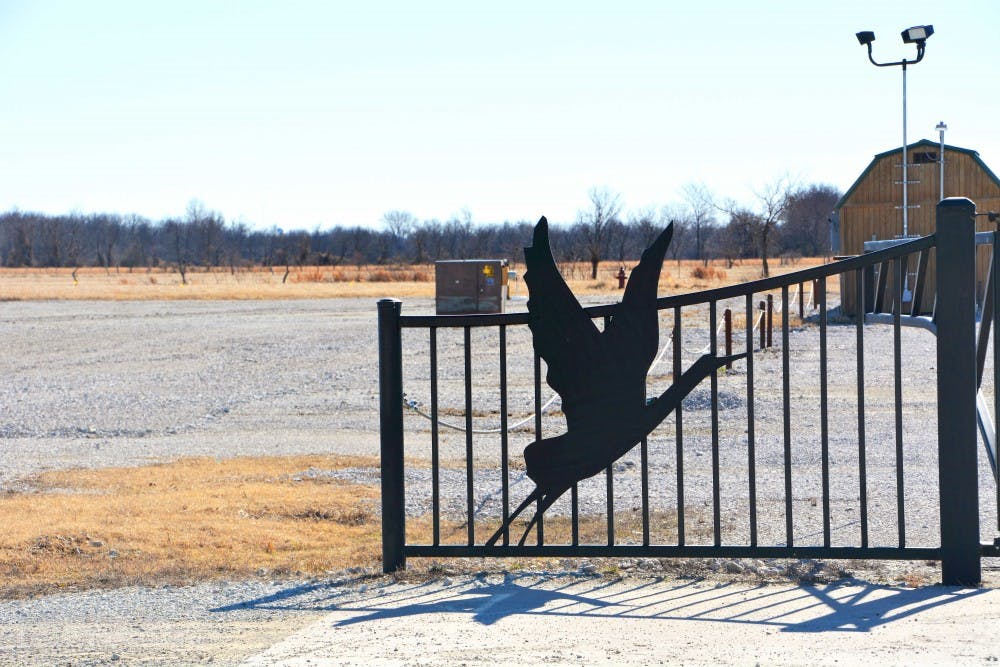MIAMI, Oklahoma -- At the Miami Tribe of Oklahoma's Winter Gathering on Saturday, Jan. 27, Jarrid Baldwin and George Ironstrack -- both Miami Tribe members, Miami University alums and Myaamia Center staff -- led its annual stomp dance.
This was the 22nd year the tribe hosted its Winter Gathering but the first year Miami Tribe members led the stomp dance.
For Myaamia people, the stomp dance is a social, not a sacred, dance, so all guests -- not just tribe members -- are welcomed and encouraged to participate.
Each dance proceeds in the same way: A male "caller" leads the dance followed by female "shakers." The women set the rhythm of the dance by stomping and shaking shells strapped around their ankles. Traditionally, the shakers were made from turtle shells but are now typically made from cans filled with small stones or beans. The dancers, alternating male and female, continue to form a spiral as more people join the dance.
During warm weather, Myaamia stomp dances are held outdoors behind the Council House. They are danced around a fire on a circular patch of grass surrounded on all sides by Oklahoma's characteristically flat stretches of land, interrupted only by the tribe's cluster of buildings, a handful of houses and some errant cattle. Summer stomps have been known to last through dawn.
During the Winter Gathering, the stomp is held inside the Council House. Callers dance around a chair or mock-fire as a stand-in for an actual flame, and shakers and other dancers fill the center of the room, which is framed by rows of benches and camp chairs.
The stomp starts after a community dinner of chili, stew and fry bread and lasts until the last caller has finished his song, typically well after midnight.
Most recently, Ben Barnes, second chief of the Shawnee Tribe, has led the Miami Tribe's stomp dances. For the last several years, Barnes has also held a "Stomp Dance 101" session during the Winter Gathering in order to prepare newcomers for what to expect and how to participate in the dance.
Barnes encouraged Miami Tribe citizens to learn how to lead the stomp and, with his guidance, Baldwin and Ironstrack started to learn and practice and, eventually, lead on their own.
Baldwin and Ironstrack first led a small social dance last summer and another small stomp dance in the fall, but last weekend's Winter Gathering stomp was the largest they have led.
"It was nerve-wracking," Ironstrack said of the experience. "Being a passive participant and being responsible for its care are two very different things."
For years, the Miami Tribe has relied on surrounding tribes to lead their stomp dances, and, though those tribes were more than willing to help, Ironstrack said, it's important that the Miami Tribe be able to reciprocate that service.
The Miami Tribe is still very new to these roles in the stomp, Ironstrack said, and recognizes that these are only small steps forward. They are like children in this, he said -- still learning and developing, but also able to help.
In the stomp dance songs that callers sing, there are places where the caller can use his own language to insert a story or narrative. Eventually, Myaamia callers could integrate the Miami language, or myaamiaataweenki, into their songs, Ironstrack said.
Quite a few Myaamia students have expressed interest in becoming callers, Ironstrack said. A growing number of women have started to train to be shakers or have shown interest in learning.
With Baldwin and Ironstrack now able to lead, that knowledge, Ironstrack said, can create a feedback loop which accelerates the spread of that knowledge throughout the tribe.
"In our own community, it means that, internally, we become capable of doing things for our own community," Ironstrack said.
Whereas Baldwin and Ironstrack had to travel to Oklahoma to learn and practice leading the stomp, Ironstrack hopes to hold practices in Oxford to spread the knowledge and responsibility of being leaders, callers and shakers throughout the tribe.

